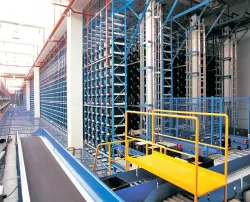Features of Steel Pallets
2024-06-21
Steel pallets are sturdy platforms designed for the storage and transportation of goods, providing durability and strength suitable for various industrial and commercial applications. Here’s an overview of steel pallets for cargo storage, including their features, benefits, and typical uses:
Features of Steel Pallets:
1. Material and Construction:
- Steel Construction: Made from robust steel materials, such as carbon steel or stainless steel, ensuring high strength and durability.
- Welded Joints: Welded construction enhances stability and load-bearing capacity, making steel pallets suitable for heavy-duty applications.
2. Design Variations:
- Open Deck: Some steel pallets have an open deck design with bars or slats, allowing easy access for forklifts and ensuring good ventilation.
- Closed Deck: Others feature a closed deck with solid steel plates, suitable for smaller items or containers that require a flat surface.
3. Load Capacity:
- Steel pallets are designed to support heavy loads, typically ranging from several hundred kilograms to several metric tons, depending on the size and design.
4. Durability:
- Resistant to impact, moisture, and temperature variations, making them suitable for both indoor and outdoor storage environments.
5. Longevity and Maintenance:
- Steel pallets have a longer lifespan compared to wooden or plastic pallets due to their resistance to wear, corrosion, and damage.
Benefits of Steel Pallets:
1. Strength and Stability:
- Ideal for storing and transporting heavy or bulky items, providing reliable support and stability during handling and storage.
2. Reusable and Recyclable:
- Steel pallets are reusable across multiple cycles and can be recycled at the end of their lifespan, contributing to sustainability initiatives.
3. Fire Resistance:
- Steel pallets are non-combustible and have inherent fire-resistant properties, enhancing safety in industrial settings.
4. Compatibility:
- Compatible with various handling equipment such as forklifts, pallet jacks, and automated storage systems, facilitating efficient logistics operations.
5. Hygienic:
- Easy to clean and maintain, making them suitable for industries with strict hygiene requirements, such as pharmaceuticals and food processing.
Typical Applications of Steel Pallets:
1. Warehousing and Distribution:
- Used for storing and transporting goods within warehouses, distribution centers, and logistics hubs where durability and load-bearing capacity are critical.
2. Manufacturing and Production:
- Support storage and movement of raw materials, work-in-progress items, and finished products on assembly lines and manufacturing floors.
3. Heavy Industries:
- Commonly used in sectors such as automotive, aerospace, and construction for handling large components, machinery parts, and industrial equipment.
4. Export and International Shipping:
- Suitable for international shipping and freight forwarding due to their robust construction and compliance with international standards.
5. Storage in Harsh Environments:
- Ideal for outdoor storage and in environments with high humidity, fluctuating temperatures, or exposure to chemicals and corrosive substances.
Considerations for Using Steel Pallets:
1. Cost and Investment:
- While steel pallets may have a higher upfront cost than wooden or plastic alternatives, their durability and longevity often result in lower total cost of ownership over time.
2. Weight and Handling:
- Steel pallets are heavier than other types of pallets, which may affect handling efficiency and labor requirements during loading and unloading.
3. Customization:
- Consider customized designs or additional features such as removable sides, stacking capabilities, or anti-slip coatings to meet specific storage and handling needs.
4. Regulatory Compliance:
- Ensure compliance with industry standards and regulations for load capacity, dimensions, and safety requirements when selecting steel pallets for use.
In summary, steel pallets offer a robust solution for cargo storage and transportation, providing strength, durability, and versatility across various industrial and commercial applications. By choosing the appropriate design and configuration, organizations can optimize storage space, enhance logistics efficiency, and ensure reliable handling of goods throughout their supply chain operations.



